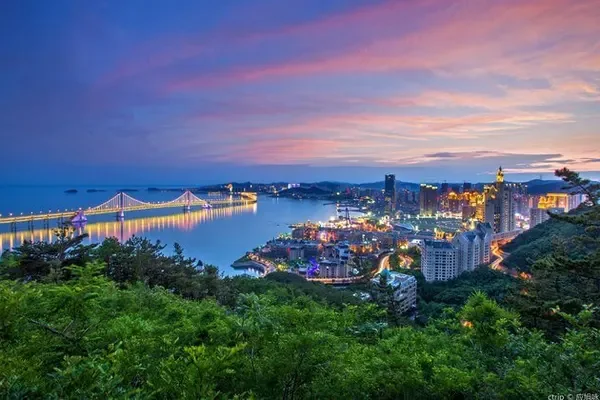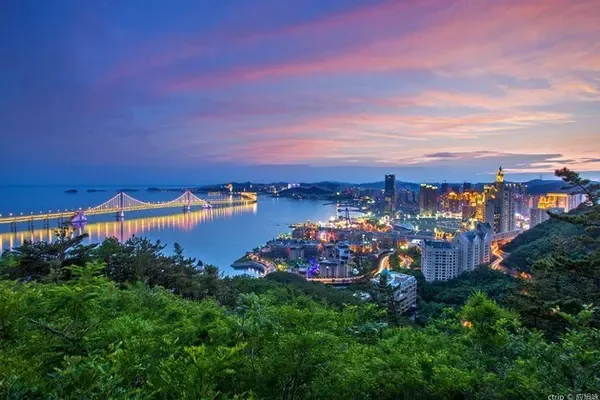★Tourist location: Zhijin Cave in Zhijin County, Bijie, Guizhou
When we walked to the entrance of the cave, we were shocked. It was just a welcome hall at the entrance of the cave, and the scale was very large. It is said that Zhijin Cave is the cave with the highest density of cave halls in the world, and its cave halls are also quite famous. Most of the caves discovered at home and abroad have only one to five cave halls, but most of the halls with an area of 10,000 square meters have only one or two halls. In Zhijin Cave, there are 13 halls with a floor area of more than 3,000 square meters, six halls with an area of more than 10,000 square meters, and the largest cave hall with an area of more than 30,000 square meters, which can be called the largest cave hall in the world. group.
There is also a skylight at the entrance of the cave, which is in the shape of an oval, and the green outside the cave can be seen. There is no sun today, and the light shining down is very soft. It is said that this place is also called "a round light and a hole in the sky". When the weather is fine, the light shining down will be very beautiful. This is the first scenic spot of Zhijin Cave, "the sun and the moon shine together". The cave entrance is the "sun", and the skylight is the "moon".
The first hall is the welcome hall, with an area of 3015 square meters. The opening is very spacious, because there are not many artificial lights in the hall, almost all natural light. The stalactites on the roof of the cave have been polished into various shapes by nature, and large stalagmites and wall flow stones can be seen everywhere.
Next to it is a stalactite with a height of more than ten meters, which looks like a mushroom. There are hardly too many dazzling lights here, only a ray of red at the junction of the mushrooms.
The "Hercules Cup" is a torch-shaped stalagmite. The stalagmites hanging around it have been connected to the stalactites on the ground, and this stalagmite really looks like the Hercules Cup held by a world champion, shining brightly under the warm light Hui.
The stalagmites and stalactites in Pipa Palace are larger in scale and in different shapes. This palace is not too big, but the stalactites lined up are still amazing. The most famous scenic spot is the "upside-down pipa". We are a little far away. From this angle, it really looks like a pipa hanging upside down, which is very vivid.
The Tallinn Palace is also amazing, covering an area of more than 16,000 square meters. The stalactites rise up one by one, like pagodas, octagonal, square, and round... The so-called "Tallinn", it is estimated that the stone tower exceeds the One hundred seats. These stalactites have stood here for many years, the humidity in the cave is relatively high, and the edges have been eroded to be very round. Some towers stand proudly alone, and some towers form forests. This scale makes tourists amazed. There is no need to conceive some unique names for them artificially. Every stalactite is an ancient tower. The lines on the tower body are traces left by the years.
The tallest tower is more than 30 meters high, and the circumference of the bottom is also about 20 meters. These towers are roughly divided into eleven small halls, with stalagmites, stone pillars, and stone curtains all over the place.
"Dragon and Tiger Fighting" is a set of waterfall-like stone mantles, without the blessing of too many colored lights, the true color of yellow and brown looks more vivid. Some tourists even counted the number of dragons and tigers with great interest. Of course, everyone's final conclusions were different, and they were not convinced by each other.
There are some stalagmites still developing, especially with signs. However, the development of stalactites is something that we cannot distinguish with the naked eye. It may have grown by only one centimeter in decades.
"Snow-pressed green pines" are two typical pine-shaped stalagmites. The lower part of the stone mantle is wider and the upper part is narrower, just like tall and straight green pines. One is five meters high, and the other is almost twenty meters high. If you look carefully, you can really see that the stalactites on the trunk resemble needles, and the "snow" pressed on the pine needles has different shapes.
Another group of pine-shaped stalagmites "Millennium Iron Tree" is also very vivid, but it looks more like a Christmas tree. The branches and leaves of the iron tree will spread out a little more, and it is more like a pine tree, but there are no snowballs on the "branches".
"Zhijin bamboo fungus" is very interesting. In fact, we don't eat bamboo fungus very often. Fortunately, we have seen it before. It looks like an umbrella, which is really very vivid.
There was a circle of tourists in front of us, and we walked over curiously, and it turned out to be a round stalagmite. Generally speaking, the upper part is round and smooth, while the middle part has stalactite lines.
In front is the birthday palace, and when you walk in, you can see "old birthday stars" bent over and carrying their backs. These stalactites are generally tower-shaped, but not as beautiful as the stone towers of the Tallinn Palace. The upper part protrudes slightly, like an old birthday star with a long beard. Some stalagmites have a stalactite hanging from the "hand", which looks like a crutch, which is clearly an Antarctic fairy in a fairy tale!
There is a "bloodstone" next to it, which looks crystal clear and crimson, in the shape of a peacock spreading its tail. This color is probably part of the rock itself, and the other part is the effect of the light. The lights here are colorful and seem to be deliberately creating a magnificent pattern.
"Banna Morning Shadow" gathers all kinds of stalactites, stalagmites, stone mantles, stone pillars, stone flags, stone mills, etc., which are a vivid picture of life scenes. I have never been to Banna, so I don't know how similar it is to the scene in Xishuangbanna. Think of it as a scene in the corner of Xishuangbanna, otherwise, as a scenic spot in Guizhou, there is no need to choose the geographical name of Yunnan.
The Miaoling Hall is very spectacular. Standing on the railing on the steps, you can see the stalactites of various shapes fluctuating up and down. Guizhou is mountainous, so the so-called Miaoling Mountains are naturally uneven. Of course, flat caves like the Linwu Cave in Xishan, Suzhou are quite rare, and most karst caves are "carved" into uneven shapes by nature. The stalagmites here are relatively huge, and there are some stone pillars and wall flow stones.
"Deep love between mother-in-law and daughter-in-law" is very interesting. Maybe the addition of lighting is really vivid when viewed from a certain angle. An old woman is sitting on a chair, and a young woman behind her is dressing her mother-in-law.
"Fu Lu Shou" is composed of a group of pine-shaped and round-shaped stalagmites. In fact, "Fu" and "Lu" are a bit abstract, but "Shou" looks like a birthday star.
"Longevity Mountain" is a giant accumulation formed by cave collapse. It is a typical cave collapse landscape. It is mainly composed of collapsed boulders and stalactites.
"Zhijin Lighthouse", also known as "Yan'an Pagoda", may be shaped like a certain pagoda in Yan'an, because I have never been to Yan'an, so there is no way to check the number. This stone pillar is actually a tower-shaped stalagmite, but it is very thin and "stands" abruptly on a slightly flat ground.
Going further, there is a very wide area, and the bathroom is actually quite spacious. When we walked to Wanghu Mountain, we checked the map and found that there were still two scenic spots at the fork in front of us. It was so easy to come to Zhijin, and naturally we didn't want to leave any regrets, so we went back and took another fork.














































































































